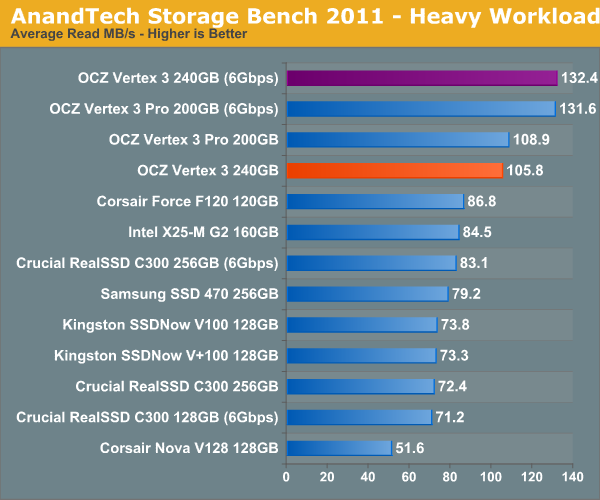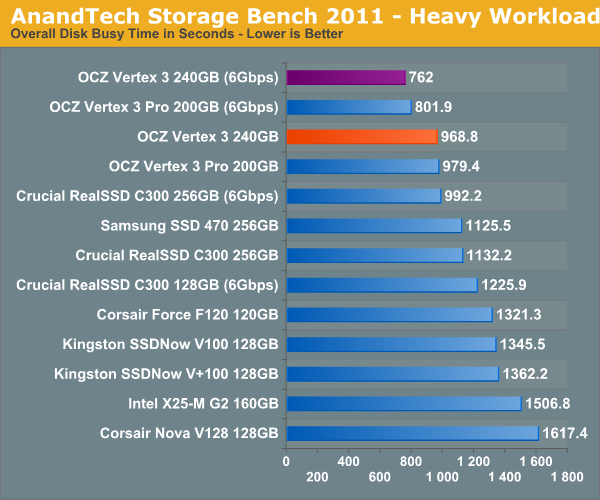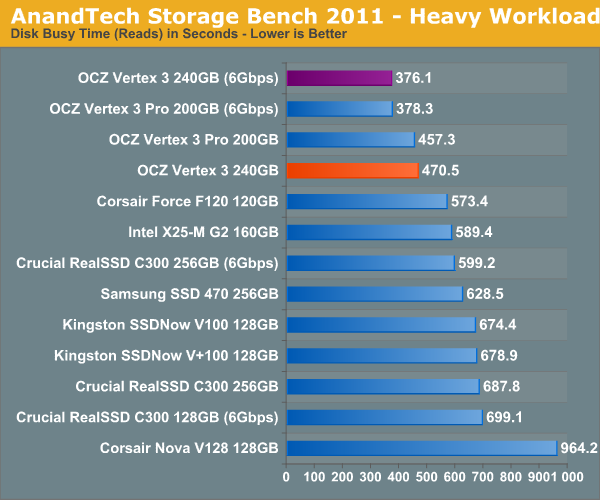OCZ Vertex 3 Preview: Faster and Cheaper than the Vertex 3 Pro
by Anand Lal Shimpi on February 24, 2011 9:02 AM ESTAnandTech Storage Bench 2011: Much Heavier
I didn't expect to have to debut this so soon, but I've been working on updated benchmarks for 2011. Last year we introduced our AnandTech Storage Bench, a suite of benchmarks that took traces of real OS/application usage and played them back in a repeatable manner. I assembled the traces myself out of frustration with the majority of what we have today in terms of SSD benchmarks.
Although the AnandTech Storage Bench tests did a good job of characterizing SSD performance, they weren't stressful enough. All of the tests performed less than 10GB of reads/writes and typically involved only 4GB of writes specifically. That's not even enough exceed the spare area on most SSDs. Most canned SSD benchmarks don't even come close to writing a single gigabyte of data, but that doesn't mean that simply writing 4GB is acceptable.
Originally I kept the benchmarks short enough that they wouldn't be a burden to run (~30 minutes) but long enough that they were representative of what a power user might do with their system.
Not too long ago I tweeted that I had created what I referred to as the Mother of All SSD Benchmarks (MOASB). Rather than only writing 4GB of data to the drive, this benchmark writes 106.32GB. It's the load you'd put on a drive after nearly two weeks of constant usage. And it takes a *long* time to run.
I'll be sharing the full details of the benchmark in some upcoming SSD articles (again, I wasn't expecting to have to introduce this today so I'm a bit ill prepared) but here are some details:
1) The MOASB, officially called AnandTech Storage Bench 2011 - Heavy Workload, mainly focuses on the times when your I/O activity is the highest. There is a lot of downloading and application installing that happens during the course of this test. My thinking was that it's during application installs, file copies, downloading and multitasking with all of this that you can really notice performance differences between drives.
2) I tried to cover as many bases as possible with the software I incorporated into this test. There's a lot of photo editing in Photoshop, HTML editing in Dreamweaver, web browsing, game playing/level loading (Starcraft II & WoW are both a part of the test) as well as general use stuff (application installing, virus scanning). I included a large amount of email downloading, document creation and editing as well. To top it all off I even use Visual Studio 2008 to build Chromium during the test.
Many of you have asked for a better way to really characterize performance. Simply looking at IOPS doesn't really say much. As a result I'm going to be presenting Storage Bench 2011 data in a slightly different way. We'll have performance represented as Average MB/s, with higher numbers being better. At the same time I'll be reporting how long the SSD was busy while running this test. These disk busy graphs will show you exactly how much time was shaved off by using a faster drive vs. a slower one during the course of this test. Finally, I will also break out performance into reads, writes and combined. The reason I do this is to help balance out the fact that this test is unusually write intensive, which can often hide the benefits of a drive with good read performance.
There's also a new light workload for 2011. This is a far more reasonable, typical every day use case benchmark. Lots of web browsing, photo editing (but with a greater focus on photo consumption), video playback as well as some application installs and gaming. This test isn't nearly as write intensive as the MOASB but it's still multiple times more write intensive than what we were running last year.
As always I don't believe that these two benchmarks alone are enough to characterize the performance of a drive, but hopefully along with the rest of our tests they will help provide a better idea.
The testbed for Storage Bench 2011 has changed as well. We're now using a Sandy Bridge platform with full 6Gbps support for these tests. All of the older tests are still run on our X58 platform.
AnandTech Storage Bench 2011 - Heavy Workload
We'll start out by looking at average data rate throughout our new heavy workload test:

If we break out our performance results into average read and write speed we get a better idea for the Vertex 3's strengths:


The next three charts just represent the same data, but in a different manner. Instead of looking at average data rate, we're looking at how long the disk was busy for during this entire test. Note that disk busy time excludes any and all idles, this is just how long the SSD was busy doing something:













85 Comments
View All Comments
j.harper12 - Thursday, February 24, 2011 - link
I'm just happy that this far along, my Agility 2 is still holding up well. Thanks for all of the great reviews!Dug - Thursday, February 24, 2011 - link
Anand,Could you please run the Anandtech Storage Bench 2011 with 1 standard hard drive, even if it takes forever to run? I always like to see a reference as many of us don't have SSD yet.
Denithor - Thursday, February 24, 2011 - link
Seconded! Just run using like a Caviar Black drive so we can see how much better SSD is versus a top-of-the-line mechanical drive.Would be appreciated!
mckirkus - Thursday, February 24, 2011 - link
Thirded. Perspective is a good thing.cactusdog - Friday, February 25, 2011 - link
Fourthed, and i know a guy who wants fifthed.pandemonium - Friday, February 25, 2011 - link
Would be nice for technicalities, but you can see the comparison on the 2010 version with WD's Velociraptor.Shadowmaster625 - Thursday, February 24, 2011 - link
I would like to know how the 60GB version performs. Especially if they are cutting the number of chips in half vs the 256GB version.DarkKnight_Y2K - Thursday, February 24, 2011 - link
According to the press release on OCZ's website the Vertex 3 will be available in 120GB and 240GB capacities. The Vertex 3 Pro wil be available in 100GB, 200GB, & 400GB capacities.Hopefully they will eventually release 60GB version. I would love to have two in RAID 0.
Per Hansson - Thursday, February 24, 2011 - link
Hi, has the much talked about hibernation problem with the Sandforce drives been solved in the 2xxx series?Loosing Hibernation is pretty much a deal killer for me in a laptop :(
http://www.google.com/search?hl=en&safe=off&am...
douglaswilliams - Thursday, February 24, 2011 - link
Will these faster drives speed up virus scans?Currently, when a virus scan is running, my laptop performance is crippled.